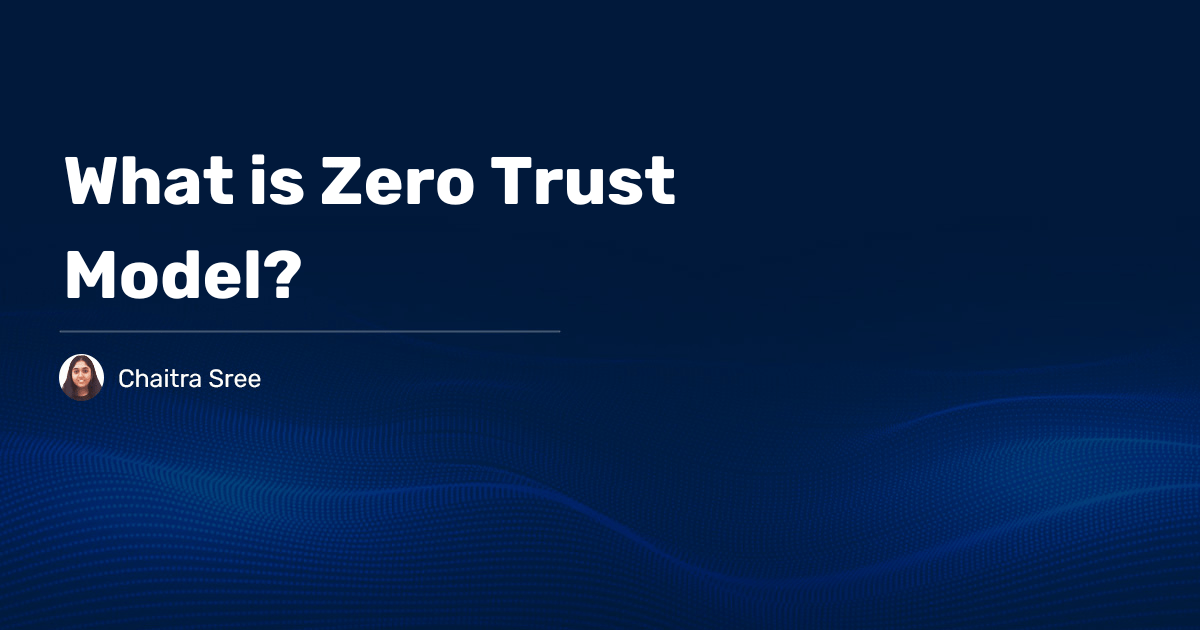In today’s world, trust is not taken for granted. Similarly, imagine a security model that questions every interaction, ensuring nothing is taken for granted for better security posture.
The zero trust security model answers the above statement.
It is a concept of eliminating blind trust and continuously verifying every data transfer surrounding the digital landscape. It is based on the “Never trust, always verify” principle coined by Forrester research analyst and thought leader John Kindervag.
In this blog, let’s explore the zero-trust security model, its benefits, and best practices in more depth.
What is Zero Trust Model?
Zero trust is an IT security model that strictly verifies every person and device that accesses the enterprise network’s resources. According to Gartner, “Over 60% of companies will implement a zero-trust security model in their infrastructure by 2025”
It is specifically designed to focus on modern complex networks and hybrid workplaces. Zero trust was mainly created to address the outdated assumption that everything present inside a network can be trusted.
But how does zero trust help in building a strong security posture?
Main Principles of Zero Trust Model
Here are the few core principles adopted by the zero-trust security model:
- Continuous Monitoring: Never give an attacker a chance to invade an IT network. Continuously monitoring for risks such as vulnerabilities, exposures, missing patches, and other security risks will not allow attackers to invade IT.
- Access Control: One of the most crucial factors zero trust depends upon is the access given to users. Zero trust needs proper information on which enterprise user has access to what resource. Based on this data, it segments and restricts other unauthenticated users.
- Multi-factor Authentication: MFA means having more than one step of security to an IT network. In addition to entering the password, users are required to enter a code/OTP, which will be sent to their mobile devices. This ensures the person accessing the files, device, or application is safe.
- Comprehensive visibility: For accurate risk detection, context-based and 360-degree visibility of all the assets present, including device type, software version, location, hostname, and operating system, is necessary.
Benefits of the Zero Trust Model
Now that we have understood the main principles on which the zero-trust model works, let’s consider the benefits enterprises will gain from adopting this security model.
- Reduces attack surface: Zero trust needs to be verified for every data transfer or access given to users. This scenario means only authorized users are allowed access to sensitive data. Adopting this method will also reduce the likelihood of cyberattacks.
- Supports compliance: A strong security strategy is a must for PCI and NIST compliance. Zero Trust will easily fulfill these requirements with its MFA and role-based access controls.
- Improved visibility: Zero Trust’s core principle is the comprehensive visibility of IT. By implementing zero trust, enterprises will have a detailed view of their assets, including the operating system, version number, IP address, and other tiny details of every asset present.
- Accurate detection: With improved visibility, risk detection becomes more accurate. The chances of detecting a false positive and missing out on risks lessen.
- Secured remote access: Remote devices transfer data using VPNs, which aren’t secure. With zero trust, hybrid workplaces are secured and will also verify employee identity for accessing applications and file transfers.
There’s no doubt that the zero-trust security model offers multiple benefits to stay ahead of cyberattacks. But how do you achieve this?
Best Practices to Achieve Zero Trust Security
- Continuously monitor the network: It’s never known when risks are detected or when attackers start invading an IT network. Continuously monitoring and being up to date with the assets is an initial step to prevent attacks. Tools like SanerNow provide continuous and 360-degree visibility of the network.
- Leverage VM tools: Detecting just vulnerabilities doesn’t safeguard enterprises. There are millions of other risks present, and using vulnerability management tools like SanerNow detects vulnerabilities, exposures, anomalies, and other critical security risks within 5 minutes.
- Instantly fix risks: Detected vulnerabilities should be remediated or mitigated ASAP. The longer a risk is present, the more vulnerable enterprises are to cyberattacks. All detected risks must be patched as soon as the patch is released or mitigated in the absence of the patch.
- Adhere to compliance standards: Every company should adhere to compliance standards such as PCI and NIST. Tools like SanerNow automatically achieve this with just a click of a button.
- Automate prevention: Once the plan is finalized, it’s a best practice to automate the process rather than running it manually every day. This will also reduce the chances of forgetting to run a process; the same manual efforts can be utilized elsewhere.
You don’t have to use multiple tools to implement/adopt these best practices. Some tools like SanerNow offer zero trust level security with its suite of 7 tools.
With SanerNow, continuous vulnerability and exposure management not only focuses on vulnerabilities with CVEs but also detects misconfigurations, anomalies, exposures, and other security risks. It also has integrated patch management that will instantly remediate risks.
SanerNow compliance management allows enterprises to adhere to compliance such as NIST, HIPAA, PCI-DSS, and STIG. Additionally, it supports all major OSs: Windows, Linux, macOS, and 550+ third-party applications.
SanerNow is also known for its fastest 5-minute vulnerability scans and the world’s first CISA-SSVC-based risk prioritization model. Schedule a demo and experience the magic of CVEM now!


